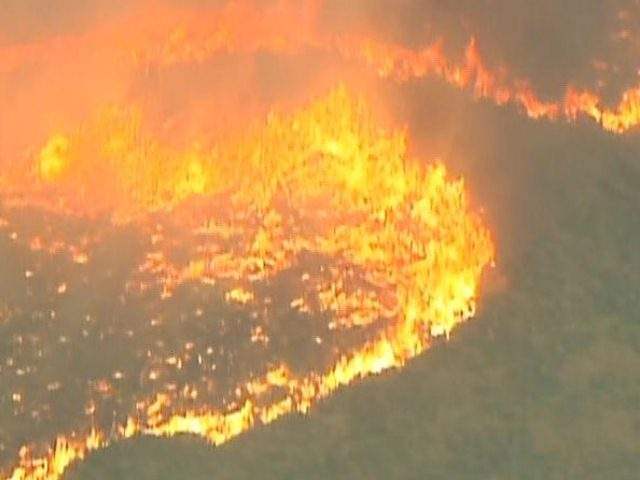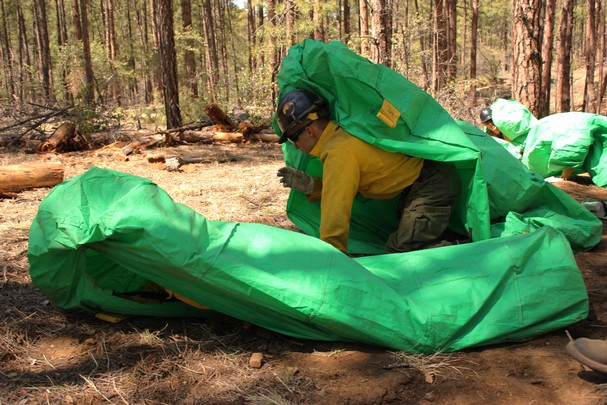America not one to advise on Fire Fighting
Tuesday, July 2nd, 2013 America tragically loses 19 elite firefighters in an Arizona Wildfire
[Source: ‘Arizona firefighter deaths’, 20130702, by Holly Yan, Eliott C. McLaughlin and Jason Hanna, CNN, ^http://edition.cnn.com/2013/07/01/us/arizona-firefighter-deaths/index.html]
America tragically loses 19 elite firefighters in an Arizona Wildfire
[Source: ‘Arizona firefighter deaths’, 20130702, by Holly Yan, Eliott C. McLaughlin and Jason Hanna, CNN, ^http://edition.cnn.com/2013/07/01/us/arizona-firefighter-deaths/index.html]
.
An American elite squad of wildfire firefighters perished last Sunday 28th June 2013 while actively setting up containment barriers in front of an out-of-control wildfire front.
The 19 firefighters who tragically perrished in the blaze were members of the Prescott Fire Department’s Granite Mountain Hotshots. The fire concerned was termed the Yarnell Hill Wildfire, about 80 km northwest of the city of Phoenix, Arizona.
Prescott Fire Chief Dan Fraijo, who sent the unit at the request of regional authorities, said he was told that one of the firefighters had radioed they were about to deploy their fire shelters, a sort of aluminum blanket that protects against the flames and heat — and a measure of last resort.
. Flawed Survival Strategy demands questions/ Class Action
Flawed Survival Strategy demands questions/ Class Action.
.
Yarnell Hill Wildfire
.
Day 1
.
The wildland fire is believed started by lighting at around 5:30 pm on Sunday 28th June 28, 2013 near the township of Yarnell (pop. 700) Arizona.
Medium winds at the time (up to 35 kph) whipped up the flames and pushed the fire out of control into a wildlife front through a tinder dry forest vegetation long subjected to an extended drought. By day’s end the wildfire has spread to over 2,000 acres (810 hectares).
A highest qualified, Type 1 elite squad of 19 wildfire firefighters (members of the Prescott Fire Department’s Granite Mountain Hotshots) were sent in ahead of the fire front to set up containment barriers to prevent the fire impacting the downwind township of Yardell. They were all overrun by the fire and perished. In the late afternoon, a Type 2 Incident Management Team (IMT) was in charge of the fire. A Type 2 fire-fighting team is a State-certified but has less training, staffing and experience than Type 1 IMTs, and is typically used on smaller scale national or state incidents.
Firefighting resources included 16 tank engines, eight water tenders, two crash/rescue vehicles, two structure protection vehicles, one bulldozer, one hotshot crew (that perished), seven type 2 handcrews and a camp crew.
On order were an additional four Type 2 crews, four Type 1 hotshot crews, one Very Large Airtanker (VLAT) and an air attack unit.
The nearby Arizona State Route 89 was shut down shortly after the fire started and the total evacuation of Yarnell and partial evacuation of Peeples Valley was ordered as well. Some 600 people were put under mandatory evacuation orders. An evacuation shelter was set up at Yavapai College in Prescott, with members of the Red Cross providing cots and blankets for overnight stays. Meals and medical assistance were also provided to residents.
A second evacuation shelter was set up at Wickenburg High School in nearby Wickenburg because the closure of State Route 89 made it impossible for some people to reach the first shelter. The two shelters are serving individuals, families and small animals; large animals were sheltered at the Hidden Springs Ranch in Peeples Valley.
.
Day 2
.
The Clay Templin’s Southwest Area Type 1 Incident Management Team assumed management of the fire. About 200 more firefighters arrived to the scorching mountains, doubling the number of firefighters battling the blaze.
By day end, half of Yarnell, about 200 to 250 homes, had been destroyed and the fire had grown to over 8,300 acres (3,360 ha).
.
Day 3
.
By the morning of July 2 the fire had grown another 798 acres to a total of 9,172 acres, as mapped by an infrared aircraft flight. The fire was still at zero containment. Resources included five Type 1 (hotshot) crews, seven Type 2 crews, three Type 1 (heavy) helicopters, two Type 2 (medium) helicopters, two Type 3 (light) helicopters, and 36 engines.
The fire was still completely uncontrolled, with more than 400 firefighters on the line.
.
Questions of the U.S. Fire Administration
.
Before the 19 deaths in Arizona, 43 firefighters had been killed so far in 2013, according to the U.S. Fire Administration. A total of 83 firefighters died last year while on duty.
This is unacceptable in 2013 in the wealthiest and most technologically advanced country on the planet.
.
- What is the cost-benefit of putting ANY firefighters (paid or otherwise) in the direct path of a firestorm? Benefit: nil? Cost: the ultimate cost?
- What were the methods of wildfire detection used by the U.S. Fire Administration at this known high risk region under extreme wildlfire weather conditions 24/7?
- Are infrared geostationary satellites in place to immediately detect wildfire ignitions in known high risk regions at known high risk weather conditions 24/7? If not, why not?
- Are wildfire ignitions monitored by satellite immediately communicated to the U.S. Fire Administration and incident crews 24/7? If not, why not?
- What was the elapsed time delay:
- Between estimated actual ignition(s) and detection by the U.S. Fire Administration? Is this time lapse acceptable to communities vulnerable during such extreme risk conditions?
- Between detection by the U.S. Fire Administration and actual onground firefighting response? Is this time lapse acceptable to communities vulnerable during such extreme risk conditions?
- Between detection by the U.S. Fire Administration and airborne water dumping hitting the fire front? Two hours? Five hours?
- Why was not multiple co-ordinated airborne response not immediately deployed within the first critically hour of the ignition to suppresss the fire while it was small and comparatively containable?
- Would such a dedicated co-ordinated military strategy have saved the 19 Granite Mountain Hotshots and the town of Yardell?
- Is the massive cost of military-scale wildlife monitoring and readiness justified to avoid loss of life in future? This is a value decision for vulnerable communuties.
.
 In 1804, one William Clark recorded perhaps the first account of a wildland fire fatality in US history.
“The Prarie was Set on fire (or cought by accident) by a young man of the Mandins, the fire went with such velocity that it burnt to death a man & woman, who Could not get to any place of Safty (sic).”
Two hundred years hence, Americans have wised up some or have they?
In 1804, one William Clark recorded perhaps the first account of a wildland fire fatality in US history.
“The Prarie was Set on fire (or cought by accident) by a young man of the Mandins, the fire went with such velocity that it burnt to death a man & woman, who Could not get to any place of Safty (sic).”
Two hundred years hence, Americans have wised up some or have they?







